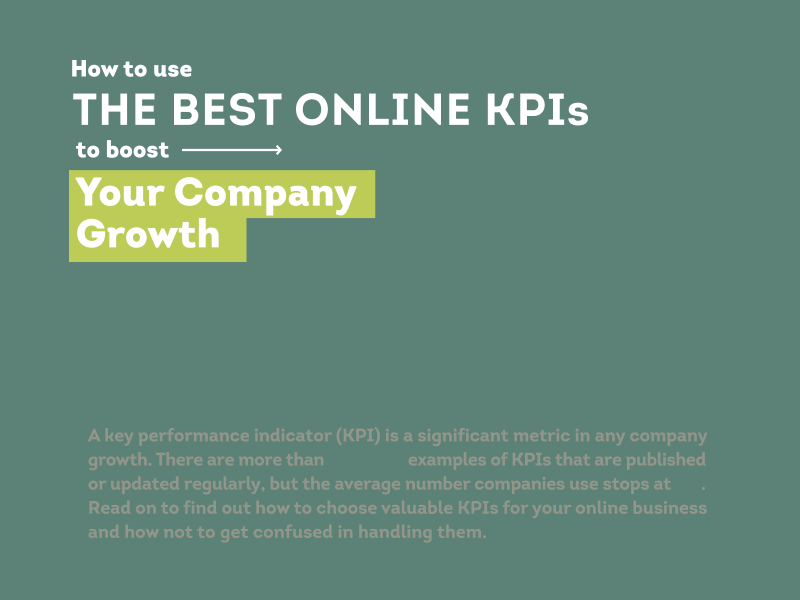
How to Use the Best Online KPIs to Boost Your Company’s Growth
Posted on April 19, 2017 9:01 am by KintanKeeping track of your business performance can be tricky when there are so many indicators to measure. The key to choosing the best key performance indicator (KPI) is to figure out which KPIs are the most valuable for your type of business, and learn how to handle them without mixing them up.
KPIs are an important growth metric, and 1 out of 4 organizations with advanced measurement programs keep track of KPIs daily or weekly. Even though there are over 20,645 examples of KPIs that are published and updated, the average company uses 10 KPIs.
Before we introduce you to different KPIs and the way they can help different businesses evaluate their progress and boost their performance, let’s get a few basics out of the way.
What Are KPIs?
In plain terms, Key Performance Indicator, or KPI, is a type of metric used to evaluate the success of a business. Businesses of all kinds use KPIs to help them figure out what their strength and weaknesses are, and to identify potential setbacks.
KPIs are presented through rates and require comparisons of facts. For instance, if you track response time KPI, you will need to regularly measure the time it takes your customer service to respond to a problem. Then, after a certain time period compare those measurements against each other to see if your response has improved.
You’ll never be able to keep track of every existing KPI — and you shouldn’t. Measuring KPIs that are not relevant to your business will be of little use. You need to choose KPIs that are measurable and that can help you evaluate where your current progress stands against your business goals. In short, effective KPIs have to be SMART: Specific, Measurable, Achievable, Relevant, and Time-Limited.
What Types of KPIs Are There?
The reason why choosing the best KPI for your business is no easy task, is the sheer number of them: there are thousands of KPIs to measure. The good news is, you need not measure any more than 10 or so.
Before we move on to discuss how different businesses use different KPIs to improve their performance, here are a few of the most used performance indicators:
- Monitoring website visitors can help you predict your target audience’s needs and adjust your content accordingly.
- Since not every site visitor becomes a customer, keeping track of the visitors to leads ratio helps you determine whether traffic is valuable.
- Conversion factor KPI depends on the total number of completed contact forms, made phone calls, or sent emails. This KPI shows what percentage of visitors engaged with your website, which helps you determine if your website is audience-friendly enough.
- Measuring leads to clients ratio helps you diagnose whether there are any obstacles that your customers might come across on the purchasing path.
- It is in your company’s best interest to contact the sales department as quick as possible. Keeping tracks of improvements in your response time can help you figure out if your customer service is on the right track or you need to speed things up a little bit more.
- Using the cost of obtaining a lead KPI means keeping track of the amount of hours and money spent on the acquisition of a lead. This can help you determine how cost-effective your marketing strategy is, and allocate your budget.
- Income from leads performance indicator helps you predict future sales based on the expected traffic and conversion rates
- Customer lifetime value calculates the projected revenue that a customer will generate during their lifetime. Keeping track of this KPI can help you determine which customers are valuable for you in the long run and what kind of content they prefer.
The Life Cycle of KPIs
There are five stages that the process of using a KPI goes though. The first one is (1) selecting the right KPI for your business. Once you’ve decided which KPIs will work best for your company, they need to be (2) approved, documented, and distributed to your staff.
The third stage in the process can be daunting since you’ll have to (3) gather and analyze large amounts of data. Collecting the wrong data will affect the results of your measurements, so you need to take your time with this stage of the KPI lifecycle.
Once your KPIs have been implemented and used for some time, they’ll have to be (4) assessed. Reporting KPIs helps you determine whether the chosen indicators are relevant for your business. Once you assess your KPIs to see if they’re effective enough in showing your business progress, you can decide on whether to (5) keep them or remove them.
Different KPIs for Different Business Models
To help you figure out what KPIs work best for different industries, here are a few types of online businesses and the KPIs they should keep track of:
|
ONLINE BUSINESSES |
KPIs |
|
B2C (Business to Consumer) |
|
|
B2B (Business to Business) |
|
|
E-Commerce Websites |
|
|
Content Sites & Blogs |
|
|
Lead Generation Websites |
|
|
Business Blogs |
|




